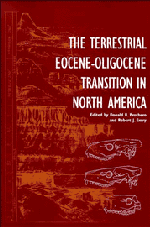Book contents
- Frontmatter
- Contents
- Contributors
- Preface
- PART I The Chronostratigraphy of the Uintan through Arikareean
- PART II Common Vertebrates of the White River Chronofauna
- 16 Testudines
- 17 Squamata
- 18 Ischyromyidae
- 19 Cylindrodontidae
- 20 Castoridae
- 21 Canidae
- 22 Nimravidae
- 23 Amphicyonidae
- 24 Small Arctoid and Feliform Camivorans
- 25 Merycoidodontinae and Miniochoerinae
- 26 Leptaucheniinae
- 27 Leptomerycidae
- 28 Camelidae
- 29 Hyracodontidae
- Summary
- Index
19 - Cylindrodontidae
Published online by Cambridge University Press: 06 July 2010
- Frontmatter
- Contents
- Contributors
- Preface
- PART I The Chronostratigraphy of the Uintan through Arikareean
- PART II Common Vertebrates of the White River Chronofauna
- 16 Testudines
- 17 Squamata
- 18 Ischyromyidae
- 19 Cylindrodontidae
- 20 Castoridae
- 21 Canidae
- 22 Nimravidae
- 23 Amphicyonidae
- 24 Small Arctoid and Feliform Camivorans
- 25 Merycoidodontinae and Miniochoerinae
- 26 Leptaucheniinae
- 27 Leptomerycidae
- 28 Camelidae
- 29 Hyracodontidae
- Summary
- Index
Summary
ABSTRACT
The rodent family Cylindrodontidae reached its greatest diversity in North America in Chadronian time, and cylindrodonts are among the most common rodents in White River faunas of Chadronian age. This chapter provides a general systematic summary of all Chadronian cylindrodont rodents, but focuses on those from the White River Group. We describe two new species, Cylindrodon natronensis and C. solarborus, from the early to middle Chadronian of the Flagstaff Rim area, Wyoming. Previously undescribed material affords much new information on the cranial and mandibular morphology of Cylindrodon and prompts a reinterpretation of its zygomasseteric structure.
INTRODUCTION
The earliest record of cylindrodontid rodents is Dawsonomys woodi from the Wasatchian of Wyoming (Korth, 1984). The family reached its greatest diversity in the Chadronian, where four genera and 13 species have been recognized, but before the end of Chadronian time the family became extinct in North America. Two subfamilies, the Cylindrodontinae and Jaywilsonomyinae, are recognized on the basis of dental characters (Wood, 1974), and can be traced back to the Bridgerian and Uintan, respectively; the subfamilial allocation of the Wasatchian Dawsonomys is uncertain, but is probably to Cylindrodontinae.
Outside North America, cylindrodontids are rare. The genus Ardynomys (originally referred to the Ischyromyidae) was first described from the latest Eocene or earliest Oligocene Ardyn Obo Formation of Mongolia by Matthew and Granger (1925). From the same deposits, Shrevyreva (1972) later named Morosomys silentiumis, which she classified as a cylindrodont; we consider Morosomys a synonym of Tsaganomys, and not a cylindrodont.
- Type
- Chapter
- Information
- The Terrestrial Eocene-Oligocene Transition in North America , pp. 399 - 416Publisher: Cambridge University PressPrint publication year: 1996
- 4
- Cited by

